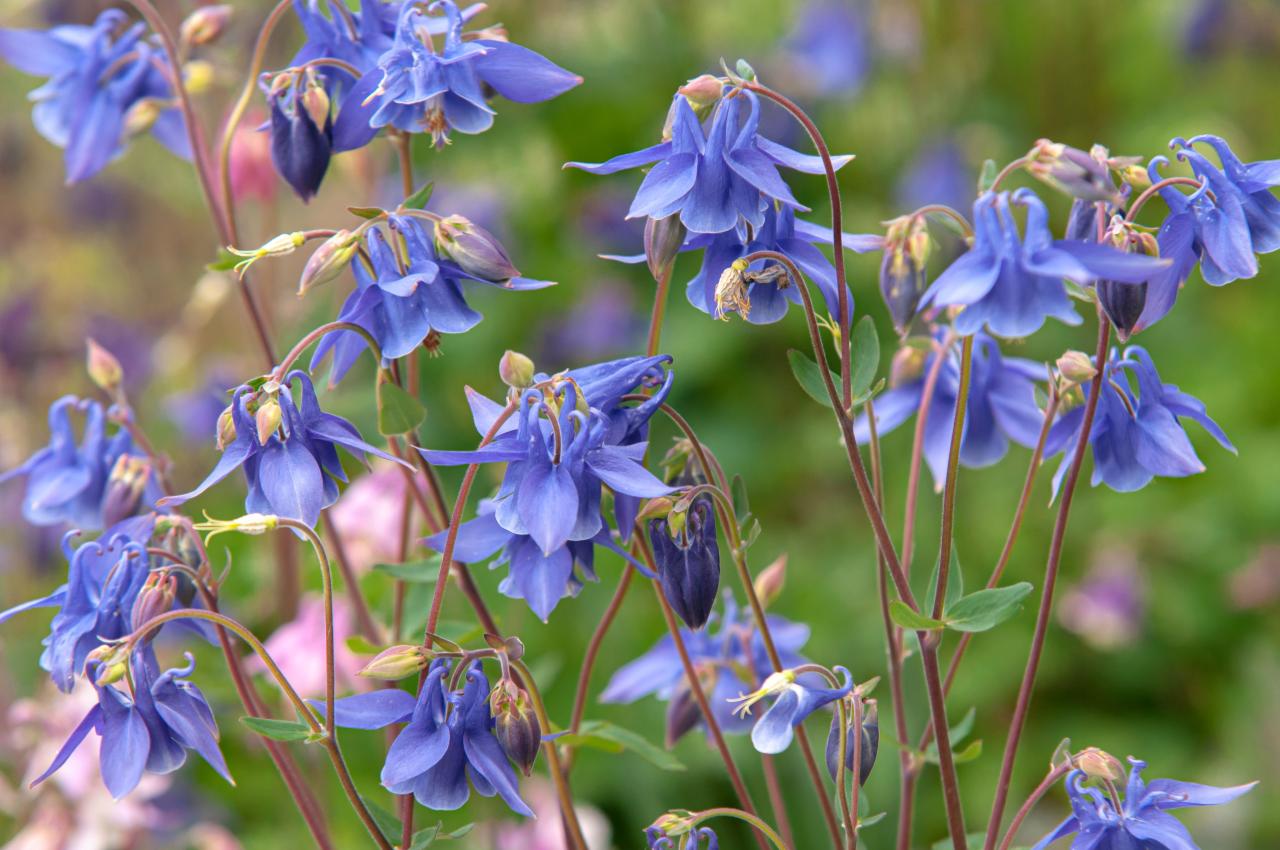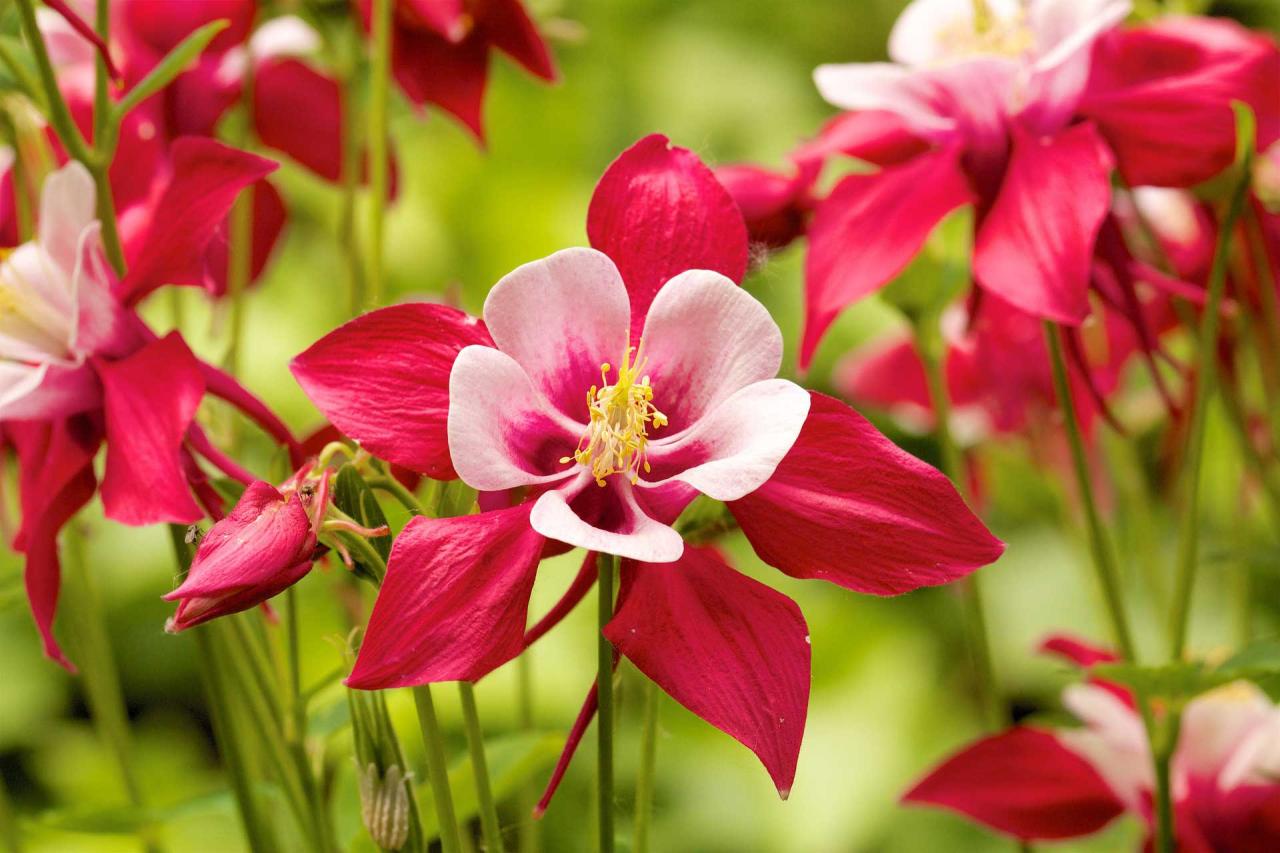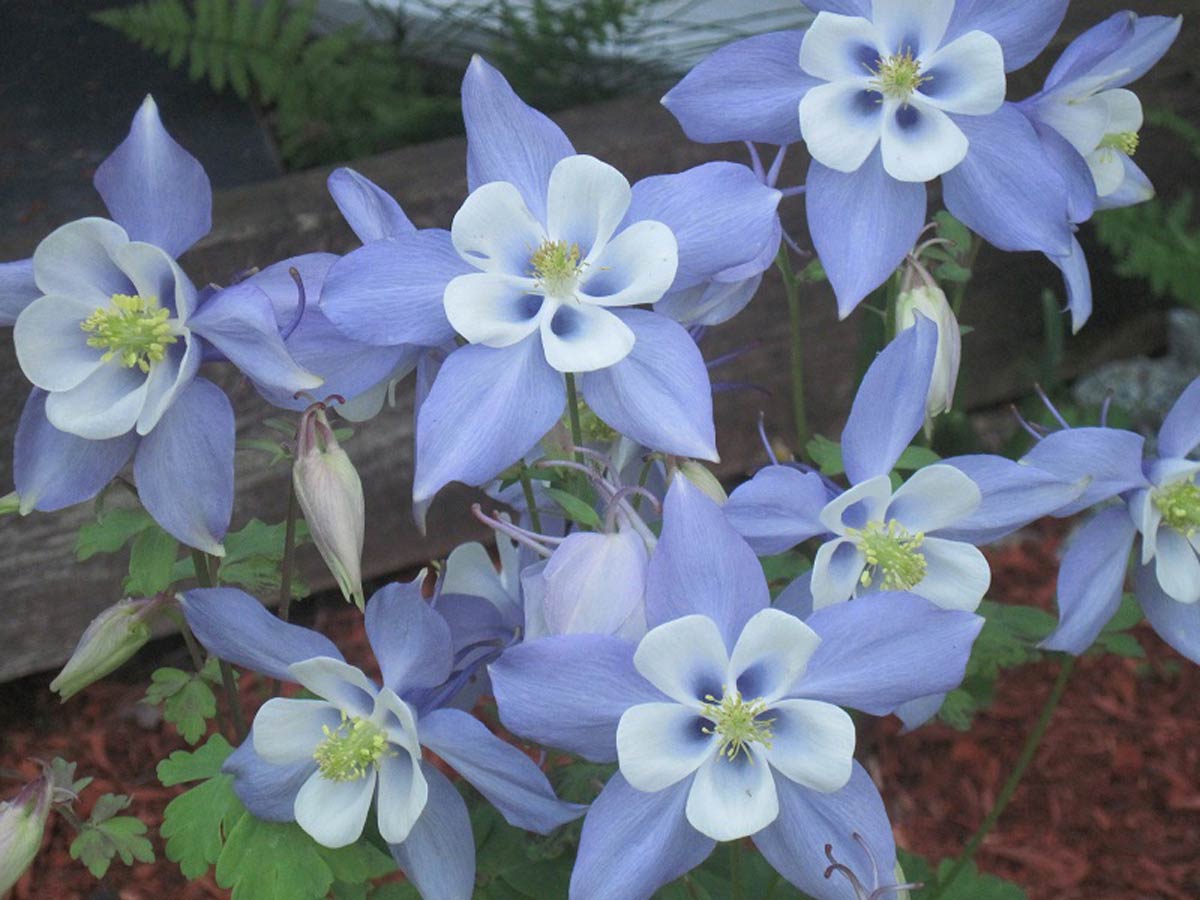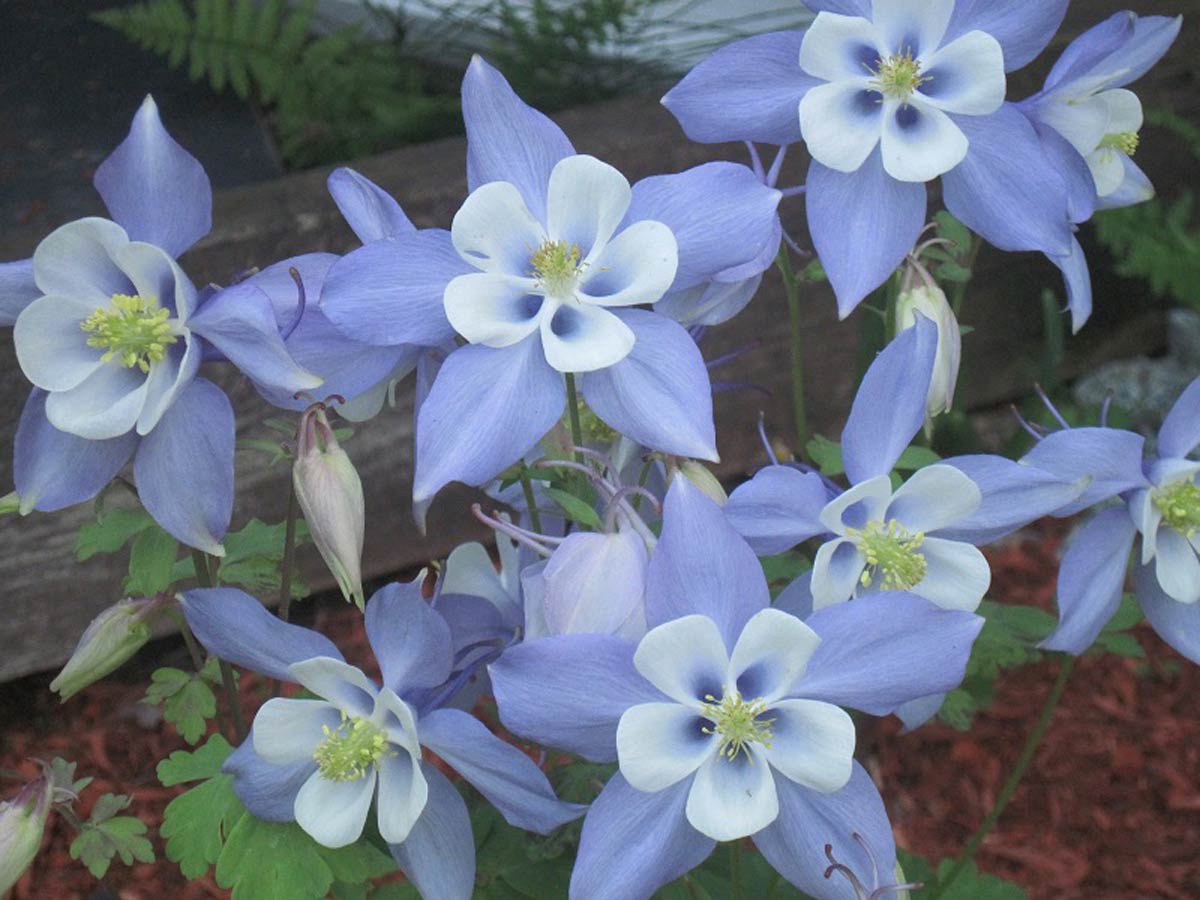Columbine Plants: Essential Tips for Beautiful Blooms – these delicate, bell-shaped flowers add a touch of whimsy and elegance to any garden. Their captivating colors and intricate patterns make them a beloved choice for gardeners seeking a vibrant and eye-catching display.
Native to temperate regions across the globe, Columbine plants (Aquilegia) thrive in a variety of climates, offering a versatile option for landscaping enthusiasts.
From choosing the right variety to understanding their cultivation needs, this guide will equip you with the knowledge to nurture these enchanting blooms. We’ll explore the intricacies of planting, caring for, and propagating Columbine plants, ensuring a bountiful display of their unique beauty.
Introduction to Columbine Plants
Columbine plants, scientifically known as Aquilegia, are captivating members of the Ranunculaceae family, renowned for their exquisite beauty and resilience. These enchanting wildflowers boast a unique charm, captivating gardeners and nature enthusiasts alike.
Distinctive Features of Columbine Plants
Columbine plants are easily recognizable due to their distinctive bell-shaped flowers, often described as resembling a group of doves clustered together. The flowers, available in a diverse palette of colors ranging from vibrant reds and blues to delicate pinks and whites, are a stunning spectacle in any garden.
Their foliage is equally appealing, featuring delicate, fern-like leaves that add a touch of elegance to the landscape.
Origin and Natural Habitats of Columbine Plants
Columbine plants are native to the temperate regions of the Northern Hemisphere, with a wide distribution across Europe, Asia, and North America. They thrive in diverse habitats, from woodlands and meadows to rocky slopes and alpine regions, demonstrating their adaptability to a range of climatic conditions.
Cultivating Columbine Plants: Columbine Plants: Essential Tips For Beautiful Blooms
Columbine plants, with their delicate, bell-shaped flowers, are a delightful addition to any garden. To ensure these beauties thrive and reward you with abundant blooms, understanding their specific needs is essential. This section will delve into the optimal growing conditions, propagation methods, and ideal planting times for Columbine plants.
Growing Conditions
Columbine plants prefer a location with partial shade, particularly in warmer climates. They thrive in cool, moist conditions and can tolerate some sun, especially in cooler regions. Avoid planting them in areas with scorching afternoon sun, as this can lead to wilting and reduced flowering.
The soil for Columbine plants should be well-drained and slightly acidic to neutral. They prefer a rich, loamy soil amended with compost or organic matter to improve drainage and provide essential nutrients. Avoid heavy clay soils, as they can lead to root rot.
Columbine plants require consistent moisture, especially during the growing season. Water them regularly, ensuring the soil is evenly moist but not waterlogged. Avoid overwatering, which can lead to root problems. During dry spells, increase watering frequency to maintain adequate soil moisture.
Propagation
Columbine plants can be propagated using various methods:
- Sowing Seeds:Columbine seeds can be sown directly in the garden in early spring or fall. Sow them thinly and cover them lightly with soil. They germinate best in cool temperatures. Alternatively, you can start seeds indoors in seed trays a few weeks before the last frost date.
- Dividing Plants:Established Columbine plants can be divided in early spring or fall. Carefully dig up the plant and separate the root ball into smaller divisions, ensuring each division has healthy roots and foliage. Replant the divisions in a prepared bed, spacing them appropriately.
- Taking Cuttings:While less common, Columbine plants can be propagated from cuttings. Take softwood cuttings in late spring or early summer. Cuttings should be about 4-6 inches long and include a few nodes. Dip the cut end in rooting hormone and plant them in a moist rooting medium.
Provide shade and keep the medium consistently moist.
Planting Time
The best time to plant Columbine plants depends on your location and climate. In regions with mild winters, you can plant them in fall. This allows the plants to establish themselves before the spring growing season. In areas with colder winters, it’s best to plant them in early spring after the last frost date.
When planting Columbine plants, ensure the soil is well-prepared and amended with compost or organic matter. Dig a hole slightly larger than the root ball and gently loosen the roots. Backfill the hole with soil, firming it gently around the plant.
Water thoroughly after planting.
Caring for Columbine Plants
Columbine plants are relatively low-maintenance, but providing proper care will ensure healthy growth and abundant blooms. This section Artikels essential practices for maintaining thriving columbine plants throughout the growing season.
Fertilizing Columbine Plants
Columbine plants benefit from regular fertilization, especially during the active growing season. Fertilizing provides essential nutrients to support healthy foliage and vibrant blooms.
- Apply a balanced, slow-release fertilizer in early spring before new growth emerges.
- Reapply fertilizer every 4-6 weeks during the growing season, depending on the type of fertilizer used and the plant’s growth rate.
- Avoid over-fertilizing, as this can lead to excessive foliage growth at the expense of blooms.
Weeding Columbine Plants
Weeding is essential for columbine plants, as weeds compete for nutrients, water, and sunlight.
- Regularly remove weeds from around the base of the plants to prevent them from taking over.
- Use a hand trowel or garden fork to carefully remove weeds, avoiding disturbing the roots of the columbine plants.
- Mulch around the base of the plants to help suppress weed growth.
Pest Control for Columbine Plants
Columbine plants are generally resistant to pests, but they can occasionally be affected by common garden pests.
- Monitor the plants regularly for signs of pests, such as aphids, spider mites, or slugs.
- Use a strong jet of water to dislodge aphids and other soft-bodied insects.
- Introduce beneficial insects, such as ladybugs or lacewings, to control pest populations naturally.
- If necessary, use insecticidal soap or neem oil to control pests, following label instructions carefully.
Maintaining Healthy Foliage
Maintaining healthy foliage is crucial for the overall health and flowering of columbine plants.
Columbine plants, with their delicate, bell-shaped flowers, add a touch of whimsy to any garden. To ensure a bountiful display, it’s crucial to provide them with the right growing conditions, including well-drained soil and partial shade. If you’re looking to bring the beauty of nature indoors, consider incorporating houseplants into your home décor, following the expert advice outlined in Rodgers Plant Tips: How to Achieve a Beautiful Indoor Garden.
Just like columbines, indoor plants thrive with the right care, adding vibrancy and life to any space.
- Provide adequate water, especially during dry periods.
- Avoid overwatering, as this can lead to root rot.
- Remove any dead or damaged leaves to prevent the spread of diseases.
- Ensure proper air circulation around the plants to prevent fungal diseases.
Promoting Abundant Blooms
Columbine plants are known for their beautiful and abundant blooms.
- Deadhead spent flowers regularly to encourage continuous blooming.
- Provide adequate sunlight, as columbine plants need at least 4 hours of direct sunlight per day.
- Ensure proper drainage to prevent waterlogging, which can hinder blooming.
Choosing the Right Columbine Varieties

With so many beautiful columbine varieties available, choosing the right one for your garden can be overwhelming. To help you make the best decision, we’ve compiled a list of popular varieties, highlighting their unique features and suitability for different garden settings.
Columbine Variety Comparison
This table compares popular columbine varieties based on their flower color, bloom time, plant height, and growing requirements. | Variety | Flower Color | Bloom Time | Plant Height | Growing Requirements ||—|—|—|—|—|| ‘Clementine’| Orange, yellow | Early Summer | 12-18 inches | Full sun to partial shade, well-drained soil || ‘Crimson Star’| Red, white | Mid-Summer | 18-24 inches | Partial shade, moist soil || ‘Black Barlow’| Dark purple, black | Late Spring | 18-24 inches | Partial shade, well-drained soil || ‘Blue Barlowe’| Blue, white | Late Spring | 18-24 inches | Partial shade, well-drained soil |
Advantages and Disadvantages of Columbine Varieties, Columbine Plants: Essential Tips for Beautiful Blooms
Each columbine variety offers unique advantages and disadvantages. * ‘Clementine’: This variety boasts vibrant orange and yellow flowers, making it an excellent choice for adding a splash of color to your garden. However, it may require more frequent watering compared to other varieties.
‘Crimson Star’
This variety produces striking red and white flowers, adding a touch of elegance to any garden. However, it prefers partial shade and moist soil, which may not be suitable for all climates.
‘Black Barlow’
This variety stands out with its dark purple and black flowers, offering a dramatic contrast to other plants. However, it can be prone to fungal diseases in humid conditions.
‘Blue Barlowe’
Columbine plants, with their delicate, bell-shaped flowers, add a touch of whimsy to any garden. For a truly unique and captivating addition, consider the Rodgers plant, Why the Rodgers Plant Should Be Your Next Garden Addition , which boasts stunning foliage and vibrant blooms.
Just like columbines, the Rodgers plant thrives in well-drained soil and partial shade, making it an excellent choice for those seeking low-maintenance beauty.
This variety features beautiful blue and white flowers, adding a cool and calming touch to your garden. However, it may not be as hardy as other varieties in harsh climates.
Incorporating Columbine Plants in Garden Design

Columbine plants, with their delicate blooms and airy foliage, add a touch of whimsy and elegance to any garden setting. Their versatility allows them to be integrated into various garden designs, creating captivating displays of color and texture.
Using Columbine Plants in Borders
Columbine plants are excellent additions to mixed borders, providing a vertical element and a burst of color. Their graceful stems and intricate blooms create a sense of movement and depth.
- Planting in front of taller plants:Columbine plants can be planted in front of taller perennials, such as coneflowers, delphiniums, or bee balm, to create a layered effect and provide visual interest at different heights.
- Creating a cascading effect:Plant columbines along the edges of a border, allowing their stems to cascade over the sides, creating a natural and flowing look.
- Planting in groups:Planting columbines in groups of three or five creates a more impactful display and enhances their visual presence in the border.
Using Columbine Plants in Rock Gardens
Columbine plants thrive in well-drained soils and are well-suited for rock gardens. Their delicate blooms and airy foliage complement the rugged beauty of rocks and stones.
- Planting in crevices:Plant columbine plants in crevices between rocks, where they can easily establish themselves and thrive in the well-drained conditions.
- Using different varieties:Incorporate a variety of columbine plants with different bloom colors and heights to create a visually appealing and diverse rock garden.
- Pairing with other rock garden plants:Combine columbine plants with other rock garden favorites such as sedums, dianthus, and alpine phlox to create a harmonious and colorful display.
Using Columbine Plants in Containers
Columbine plants can also be grown successfully in containers, adding a touch of elegance and color to patios, balconies, and window boxes.
- Choosing the right container:Select a container with good drainage to prevent waterlogging and ensure healthy growth. Terracotta pots are a good choice for columbines as they allow the soil to breathe.
- Pairing with other plants:Combine columbine plants with other container-friendly plants such as geraniums, petunias, or verbena to create a beautiful and vibrant display.
- Providing support:If planting columbines in a hanging basket, provide support for their stems to prevent them from becoming leggy or drooping.
Columbine Plant Compatibility with Other Plants
Columbine plants are generally compatible with a wide range of other plants. They complement the colors and textures of many perennials, annuals, and shrubs, creating visually appealing combinations.
- Perennials:Columbine plants pair well with perennials such as coneflowers, salvia, bee balm, and hostas, creating a harmonious and colorful display.
- Annuals:They can also be combined with annuals like zinnias, cosmos, and marigolds, adding a touch of elegance and whimsy to the garden.
- Shrubs:Columbine plants can be planted near shrubs such as hydrangeas, roses, and rhododendrons, creating a layered effect and adding visual interest to the landscape.
Enjoying the Beauty of Columbine Blooms
The vibrant, intricate blooms of Columbine plants are a delight to behold, but their beauty can be extended even further with proper care and attention. By implementing simple techniques, you can ensure a continuous display of these charming flowers throughout the growing season.
Extending the Blooming Period
Deadheading, the practice of removing spent blooms, is essential for encouraging continuous flowering. As Columbine flowers fade, they naturally produce seed pods. By removing these pods, you redirect the plant’s energy towards producing new buds, extending the blooming period.
- Regularly inspect your Columbine plants for faded blooms.
- Use sharp, clean shears or pruning scissors to remove the spent flower heads, cutting just below the bloom.
- Dispose of the spent blooms to prevent self-seeding, unless you desire more Columbine plants in your garden.
Proper watering is crucial for maintaining the health and vigor of Columbine plants. These plants prefer consistently moist soil, especially during dry periods. Avoid overwatering, as this can lead to root rot.
- Water deeply and infrequently, allowing the soil to dry slightly between waterings.
- Monitor the soil moisture levels, adjusting watering frequency as needed.
- Consider using a layer of mulch around the base of the plants to help retain moisture and suppress weeds.
The Role of Pollinators
Columbine plants rely on pollinators, such as bees, butterflies, and hummingbirds, to transfer pollen between flowers, facilitating fertilization and seed production. These pollinators play a crucial role in the life cycle of Columbine plants and contribute to the overall biodiversity of the garden ecosystem.
- The vibrant colors and unique shapes of Columbine flowers attract pollinators, providing them with nectar and pollen.
- By supporting pollinators, you contribute to the health and vitality of your garden and the surrounding environment.
- Encourage pollinator activity by planting a variety of flowering plants that bloom throughout the growing season.
Harvesting Columbine Seeds
Once Columbine flowers have faded, they develop seed pods that contain numerous seeds. These seeds can be harvested and used to propagate new Columbine plants, ensuring the continuation of these beautiful blooms in your garden.
- Allow the seed pods to mature fully, turning brown and dry.
- Gently twist or cut the seed pods from the plant, ensuring they are completely dry.
- Store the seeds in a cool, dry place in an airtight container for future planting.
Columbine seeds typically retain their viability for up to three years when stored properly.
End of Discussion

With a little care and attention, Columbine plants will reward you with a stunning display of color and intricate detail. Their captivating blooms will draw the eye and attract a variety of pollinators, adding a touch of magic to your garden.
From choosing the perfect variety to mastering the art of propagation, the journey of cultivating Columbine plants is an enriching one, offering a deep appreciation for the beauty and resilience of nature.
Common Queries
What is the best time to plant Columbine seeds?
Columbine seeds can be sown directly in the garden in the spring or fall. However, starting them indoors a few weeks before the last frost can give them a head start.
Are Columbine plants deer resistant?
While Columbine plants are generally deer-resistant, they may be nibbled on occasionally. If deer are a problem in your area, consider planting them in a protected location or using a deer repellent.
How long do Columbine plants live?
Columbine plants are short-lived perennials, typically lasting for 2-3 years. However, they often self-seed, ensuring a continuous supply of blooms in your garden.
